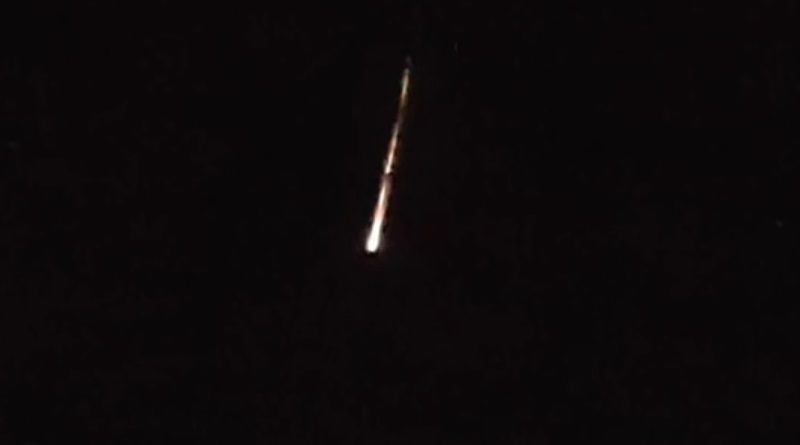Re-Entry of Soyuz Rocket Stage surprises New Zealanders
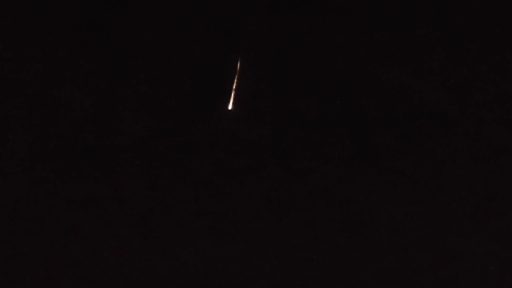
The fiery demise of a Soyuz rocket stage surprised observers in New Zealand Tuesday night, sparking dozens of reports of a bright meteor over the South Island.
Videos and photos quickly emerged on Social Media and showed the typical appearance of a re-entering piece of man-made space debris with the timing of the event being consistent with the re-entry of the Block I third stage of the Soyuz rocket that sent an unpiloted Progress freighter to the International Space Station Saturday night.
According to press reports, several calls were made to the police around 6:30p.m. alerting authorities of a massive fireball appearing on the evening skies. Witnesses reported seeing the object for at least 30 seconds, in the process breaking into several parts – consistent with a re-entering space vehicle shedding fragments in the upper atmosphere.
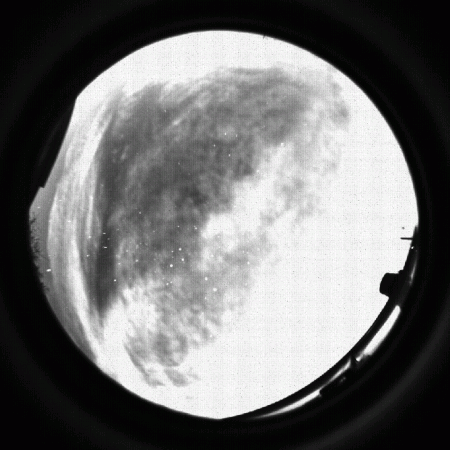
Soyuz Block I stages are often seen re-entering the atmosphere due to the rapid launch rate of the Russian workhorse and the fact that its third stages often end up in short-lived orbits, especially for crewed Soyuz missions and Progress cargo flights to the Space Station.
Being a sizeable object, the Block I stages can put on a spectacular show when re-entering in darkness, breaking up in a bright fireball that can remain visible for up to a minute.
The Soyuz U rocket carrying the Progress MS-03 cargo ship lifted off from the Baikonur Cosmodrome at 21:41 UTC on Saturday and successfully reached orbit eight minutes and 45 seconds later. Progress MS-03 was separated from the upper stage and successfully raised its orbit to link up with the Space Station at 0:20 UTC on Tuesday, leaving the Block I stage behind in a 200-Kilometer orbit with an expected lifetime of around three days.
It this particularly low orbit, plenty of atoms and molecules are present to cause drag on the upper stage and slow it down, causing it to lose altitude. Because spent rocket stages have a low mass and large surface area, their descent toward the dense layers of the atmosphere is relatively fast. Descending in altitude, the speed of orbital decay accelerates and rockets from Progress/Soyuz launches typically meet their fiery end two to four days after launch depending on atmospheric conditions driven by solar activity.
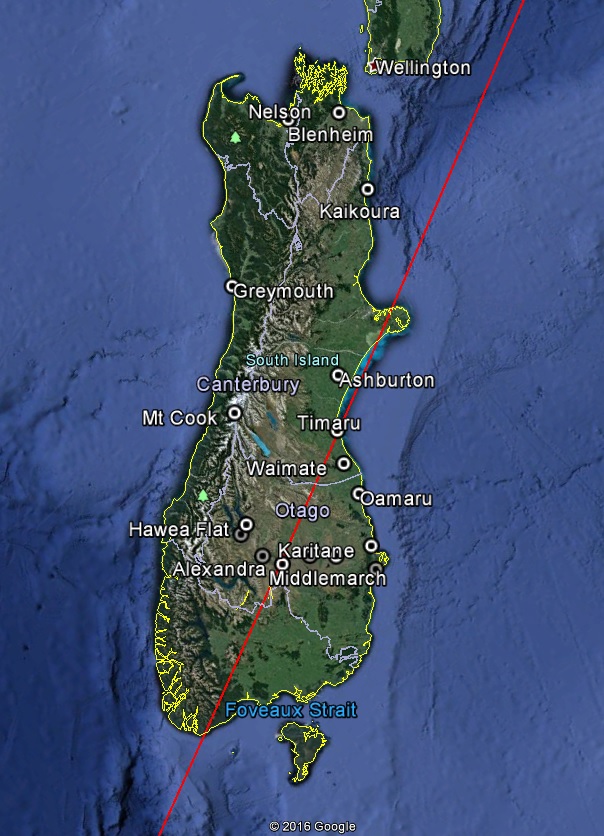
Approaching its deadly dive into the atmosphere, the Block I stage crossed over Africa and Madagascar before passing over the Indian Ocean, heading into orbital night south of Tasmania. Its ground track over the South Island of New Zealand took the rocket body straight over Alexandra, Timaru and west of Christchurch. Observation reports came from a 570-Kilometer stretch from Alexandra and Cromwell all the way north to Nelson and Blenheim.
As plasma built up around the stage, starting around 104 Kilometers in altitude, it became visible as a small dot moving across the sky. Hitting the dense layers of the atmosphere, heat started building up on the stage and drag at the high entry speed of 7.8 Kilometers per second quickly built up to a destructive force, causing the rocket body to break apart.
The disintegration of the stage and the individual components, each in a blaze of fire can be seen in videos published on the Internet. One brighter piece pulls out in front of the smaller debris – likely the heavy engine section of the rocket stage representing the most dense component with the highest kinetic energy.
Given the extremely high speed of the object at Entry Interface, air in front of the vehicle is compressed, creating a shock wave layer in which molecules are separated into ions and temperatures rise to the extreme.
The Entry Point, defined by USSTRATCOM at an altitude of 80 Kilometers, marks the beginning of of the disintegration of the spacecraft (+/-10km) due to drag building up to a destructive force, triggering the onset of fragmentation of the spacecraft structure. The shock wave layer forming just in front of the spacecraft and any separated components leads to considerable heating that causes the incineration of the majority of the spacecraft structure.
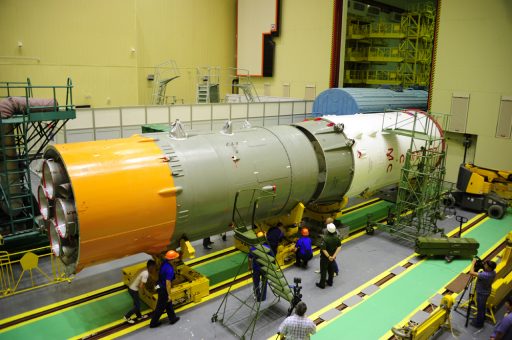
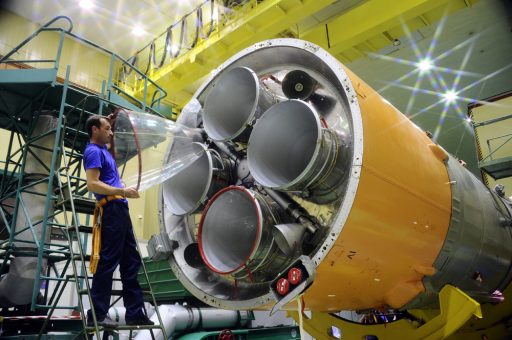
The mechanical deceleration experienced during re-entry can be up to 20Gs further crushing the structural components and causing the break-up of the spacecraft. Temperatures reached during re-entry can melt most metal types used on the spacecraft and most of the fragments created on entry fully burn up, leaving a cloud of dust in the upper atmosphere.
This is especially true for rocket bodies that consist for a large part of thin metal that forms the propellant tanks. However, dense components such as spherical pressurant tanks and engine components can survive re-entry and reach the ground.
The Block I stage employed by the Soyuz U rocket measures 2.66 meters in diameter and is 6.74 meters long with a total mass of 2,410 Kilograms, powered by a single RD-0110 engine with four combustion chambers, delivering 30 metric-ton-force of thrust during the stage’s four minutes of operation. The heavy engine section weighs 410 Kilograms.
Dense components that survive re-entry usually impact 800 to 1,300 Kilometers downrange from the Orbital Decay Point – Atmospheric properties such as crosswinds play a significant role during atmospheric descent. Based on the location of re-entry observations, the impact point is likely located west of New Zealand’s main islands.
Re-Entry Data
NORAD ID: 41671
Object: SL-4 R/B
Origin: Russia
Type: Block I Soyuz Upper Stage
Mass: 2,410 Kilograms
Launch: July 16, 2016 – 21:41:46 UTC
Launch Site: 31/6 Baikonur Cosmodrome
Launch Vehicle: Soyuz U
Ascent Duration: 8 Minutes & 49 Seconds
Payload: Progress MS-03 (7,290kg)
Target Orbit: 193 by 238km, 51.67°
Last Orbit Data: 164 by 194km, 51.67°
Re-Entry Prediction: July 19, 2016 – 06:30 UTC
Re-Entry Location: South Island, New Zealand

